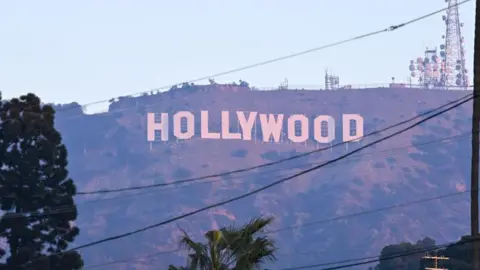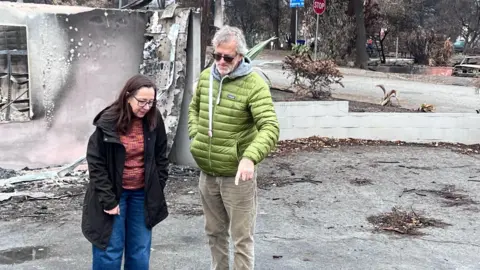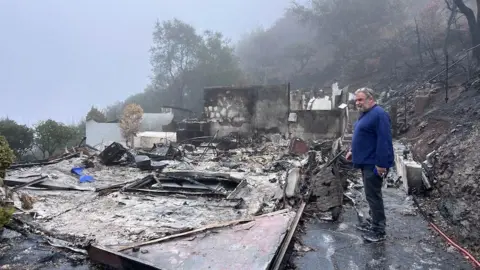Hollywood’s Production Crisis Deepens Amid Wildfires and Shifting Economic Incentives
Table of Contents
- Hollywood’s Production Crisis Deepens Amid Wildfires and Shifting Economic Incentives
- The Impact on Local Talent and Infrastructure
- Tax Incentives and the Outmigration of Productions
- The Broader Economic and Cultural Implications
- Personal Resilience and Future Prospects
- Frequently Asked Questions
- What factors are contributing to Hollywood’s current production crisis?
- how have wildfires impacted local talent and production infrastructure?
- Why are film and television productions leaving Los Angeles?
- What measures are being proposed to revive local production in Los Angeles?
- What are the broader economic and cultural implications mentioned in the article?
- How are local creatives coping with these challenges?
Los Angeles, California – Febuary 14, 2025

Hollywood, long celebrated as the dream factory and the heart of the global entertainment industry, is grappling with a multifaceted crisis as wildfires further exacerbate a longstanding trend away from Los Angeles-based production. Increasingly, film and television crews are heading to Atlanta, London, Toronto, and Sydney, drawn by lower labor costs and lucrative tax incentives. In recent years, the economic landscape has shifted dramatically, and the destructive wildfires that have claimed at least 29 lives and razed thousands of homes have only deepened the sense of urgency among local industry professionals to revive production in the City of Angels.
The Impact on Local Talent and Infrastructure
Mark Worthington, a production designer whose home in Altadena was lost to the infernos, has witnessed firsthand the decline of local production opportunities. “The best thing the studios could do for fire relief is to bring work back for the rank and file LA film workers,” he stated, emphasizing the plight of those who have become collateral damage in the ongoing battle for economic survival.Worthington,along with his partner Mindy Elliott—a seasoned film editor—has seen his career dramatically affected by a series of challenges,ranging from COVID-19 shutdowns to labor strikes and an exhausted streaming boom.

Industry data underscores the severity of the shift: U.S. productions decreased by 26% in the past year compared to pre-strike levels in 2022, while international markets like Australia, New Zealand, the United Kingdom, and Canada have experienced modest gains. This alarming trend has made the local workforce question weather the economic and cultural legacy of Hollywood is at risk.
Tax Incentives and the Outmigration of Productions
The exodus of film productions from Los Angeles is largely tied to fiscal realities. States such as Georgia offer unrestricted tax credits, which have made cities like Atlanta magnets for filmmakers seeking to maximize profits. In contrast, the union-protected jobs in Los Angeles come with higher wages, expensive health benefits, and pension costs that studios are reluctant to absorb. This economic calculus has forced many in the industry to operate in an environment that feels less kind to both creativity and sustained local investment.
Megastar Vin Diesel recently used his social media platform to call attention to the city’s plight, posting, LA really, really, really needs production to help rebuild
and reminding fans that Los Angeles was the birthplace of the Fast and furious franchise. His remarks have resonated with many,as producers and talent alike are urged to put local productions at the forefront of their business strategies.
Nearly 20,000 entertainment workers, including high-profile actors such as Keanu Reeves, Zooey Deschanel, and Kevin Bacon, have joined a “Stay in LA” petition that calls for state leaders to suspend production tax incentive caps for LA County. This grassroots campaign, spearheaded by film director Sarah Adina Smith among others, demands that California use its emergency powers to enhance tax incentives for the next three years and secure at least a 10% increase in local productions.
“We need to bring production back to LA and get LA working again if we want to rebuild,” said Ms. Smith.
Stay in LA Campaign
The Broader Economic and Cultural Implications
Governor Newsom has proposed a notable increase in the state’s annual film and television production tax credit—from $330 million to $750 million—to spur economic growth and sustain job creation across california. The governor claims that these incentives have generated more than $26 billion in economic activity and have supported upwards of 197,000 jobs throughout the state. Such measures could establish California as one of the most generous subsidy programs in the nation, second only to states like Georgia that offer uncapped credits.
Yet, alongside these policy innovations are contrasting voices advocating for more immediate, on-the-ground solutions. Critics point to the sacrifices made by local creatives—whose lives and livelihoods have been directly impacted by the crisis—as evidence that tax credits alone are insufficient. Composer Matthew Ferraro, whose once breathtaking Topanga Canyon home now lies in ruins, expressed his skepticism about attempts to resurrect the Hollywood dream.“I think it’s wishful thinking for people who are still in love with, like yesteryear’s dream of Hollywood, but that’s just not how it works anymore,” he lamented.

The economic ripple effect reaches beyond the entertainment industry. Recent case studies from cities like Detroit reveal how the collapse of a once-thriving regional industry can leave long-lasting scars on local economies and cultural identities. Similar to detroit’s post-industrial challenges, some filmmakers worry that if the current trends continue unchecked, Los Angeles could suffer irreparable harm to its creative infrastructure.
Personal Resilience and Future Prospects
Even amid devastation, personal resilience shines through. Jamie Morse, a budding comedy writer from Topanga Canyon whose home was also lost in the fires, has chosen to view the adversity as a sign of destiny. After leaving a stable job to pursue her dreams full-time, Morse now finds temporary shelter with friends or in her car as she continues to chase opportunities with her improv troupe, The groundlings.
“Whether they’re performers or studio execs – people love this city,” said Ms. Morse, underscoring the deep personal connections that many have with los Angeles.
Jamie Morse
She reflects on the small victories amid loss: sentimental items,such as notebooks and journals containing her creative work,miraculously survived the blaze. “Where an entire stone table is, is in pieces, is like, absolutely decimated, melted,” she recalled, “But pieces of paper survived… It’s truly unbelievable.” Her outlook remains cautiously optimistic; despite the hardship, she believes that “beautiful, creative things [will] come out of this vrey, very crappy time.”
This blend of policy debate, economic challenge, and human resilience is shaping a conversation across California about how best to situate Hollywood in today’s competitive, global market. as studios weigh decisions driven by cost efficiencies against the broader cultural mandate of supporting local talent and communities, industry stakeholders are urged to consider long-term implications, balancing immediate financial interests with the enduring legacy of Los Angeles as the cradle of movie magic.
Frequently Asked Questions
What factors are contributing to Hollywood’s current production crisis?
The crisis is driven by a combination of destructive wildfires—which have claimed lives and destroyed property—and a shifting economic landscape where productions are moving away from Los Angeles for lower labor costs and attractive tax incentives offered by other cities like Atlanta, London, Toronto, and Sydney.
how have wildfires impacted local talent and production infrastructure?
Wildfires have not only devastated communities, as seen with the loss of homes in Altadena and Topanga Canyon, but have also deepened the urgency for change. Industry professionals like production designer Mark Worthington have witnessed firsthand the decline in local production opportunities, and the destruction has compounded existing challenges from COVID-19 shutdowns and labor strikes.
Why are film and television productions leaving Los Angeles?
One of the main reasons is the fiscal calculus: union-protected jobs in Los Angeles come with higher wages, expensive health benefits, and pension costs. In contrast, states such as Georgia offer unrestricted tax credits, making it more financially attractive for producers to film elsewhere.
What measures are being proposed to revive local production in Los Angeles?
Efforts to revive production include a grassroots “Stay in LA” petition, which has gathered nearly 20,000 signatures from entertainment workers, and the proposal by Governor Newsom to increase the state’s annual film and television production tax credit from $330 million to $750 million, aiming to boost economic activity and support local jobs.
What are the broader economic and cultural implications mentioned in the article?
The article highlights that the production crisis in Hollywood could lead to long-lasting economic scars similar to those observed in post-industrial Detroit. The shift in production not only threatens local employment but also raises concerns about the erosion of Hollywood’s cultural legacy and creative infrastructure.
How are local creatives coping with these challenges?
despite the hardships, figures like Jamie Morse—a comedy writer from Topanga Canyon—demonstrate personal resilience. Even after losing her home and facing displacement, Morse continues to chase creative opportunities and inspires hope that “gorgeous, creative things will come out of this very, very crappy time.”


